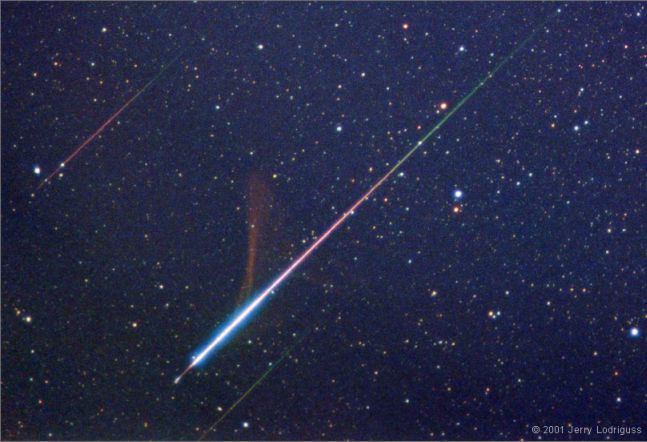Credit & Copyright: Jerry Lodriguss
Explanation:
Returning from orbit,
space shuttles enter the atmosphere at
about 8 kilometers per second as friction heats their protective
ceramic tiles to over 1,400 degrees Celsius.
By contrast, the bits of comet dust which became the
Leonid meteors
seen on November 18, were moving at 70 kilometers per second,
completely vaporizing at altitudes of around 100 kilometers.
In this
single 5 minute time exposure, three Leonid
meteors are
shooting
through skies above Spruce Knob,
West Virginia, USA.
Background stars
are near the constellation Orion.
The brightest meteor, a
fireball, dramatically changes colors along its
path and leaves a smokey
persistant trail drifting
in high-altitude winds.
From that extremely dark site, at an elevation of 1,200 meters,
astrophotographer
Jerry Lodriguss reports, "We observed a
[zenithal
hourly rate] of about 3,600 at 10:30 UT and
very high rates from 9:30 UT until well into the start
of astronomical twilight at 10:50 UT. It was quite a
spectacular storm,
with bolides going off like flashbulbs,
green and red fireballs and other fainter Leonids in all parts of
the sky."
1999 2000 2001 2002 2003 2004 2005 2006 2007 2008 2009 2010 2011 2012 2013 2014 2015 2016 2017 2018 2019 2020 2021 2022 2023 2024 2025 |
Январь Февраль Март Апрель Май Июнь Июль Август Сентябрь Октябрь Ноябрь Декабрь |
NASA Web Site Statements, Warnings, and Disclaimers
NASA Official: Jay Norris. Specific rights apply.
A service of: LHEA at NASA / GSFC
& Michigan Tech. U.
|
Публикации с ключевыми словами:
Leonids 2001 - болид - Метеорный поток - Леониды - meteor shower - fireball
Публикации со словами: Leonids 2001 - болид - Метеорный поток - Леониды - meteor shower - fireball | |
См. также:
Все публикации на ту же тему >> | |
